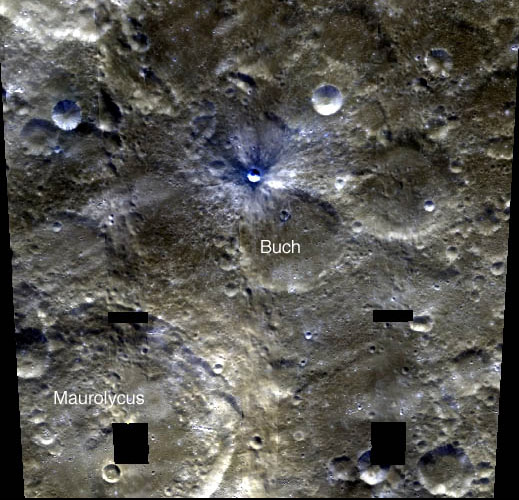
image from Clementine Ratio Image
Since Apollo there has been a lunar orthodoxy that nearly all lunar craters and basins were formed by impact, and that the volcanic eruptions which filled the basins and constructed minor landforms such as domes, rilles and dark halo craters were limited to the maria and nearby shores. But recently B. Ray Hawke and colleagues have documented the occurrence of mare material deep in the southern highlands. The non-descript 6-km wide crater Buch B lies north of Buch and NE of Maurolycus. In 1962, Gene Shoemaker and Bob Hackmann discovered a dark halo and dark rays around B, and speculated that it might be a recent volcanic explosion crater. But Buch B is a normal-looking simple impact crater with raised rim and small flat floor - it isn’t a volcanic crater at all. With modern (1994!) Clementine multispectral data, Hawke and colleagues determined that the dark materials have the iron and titanium values typical of mare basalts. Buch B also is bright in eclipse thermal imaging and radar, both indicating that the crater is very young. In fact, the dark rays from Buch B appear to be superposed on the bright rays from Tycho that cross this area. The interpretation is that Buch B is a young impact crater that excavated into a dike of mafic (material with dark-minerals) rock and spread it around in its ejecta. The mafic dike does not have to be young - it could be 3.5 billion years old, like many lunar mare basalts. Buch B illustrates that the sort of feeders that brought lavas to the mare also rose near the surface in other parts of the Moon but the crust was too thick for the dikes to reach the surface.
For the next week I will be at the Lunar & Planetary Science Conference in Houston. Most of the LPODs during this time (assuming I can get them all made) will be from the lost ones that were originally published in June 2005 on Anthony Ayiomamitis’ website. Here is the originally published version with mouseover.
Technical Details:
Clementine image made from different wavelengths using USGS Map-A-Planet.
Related Links:
Rükl chart 66
Hawke, B.R. and 6 others (2002) Igneous activity in the southern highlands of the Moon. J. Geophys. Res. 107, #E12, 5122.
Yesterday's LPOD: Bond's Back!
Tomorrow's LPOD: Amazing Pan
COMMENTS?
Register, Log in, and join in the comments.



